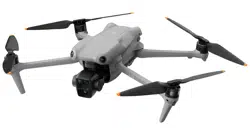Loading ...
Loading ...
Loading ...

DJI Air 3
User Manual
©
2023 DJI All Rights Reserved.
21
Flight Safety
After completing the pre-flight preparation, it is recommended to train your flying skills and
practice ying safely. Pick a suitable area to y in according to the following ight requirements
and restrictions. Strictly abide by local laws and regulations when flying. Read the Safety
Guidelines before ight to ensure the safe use of the product.
Flight Environment Requirements
1. DO NOT operate the aircraft in severe weather conditions including wind speeds exceeding
12 m/s, snow, rain, fog, hail, ice, and thunderstorm.
2. Only y in open areas. Tall buildings and large metal structures may aect the accuracy of
the onboard compass and GNSS system. It is recommended to keep the aircraft at least 5 m
away from structures.
3. Avoid obstacles, crowds, high-voltage power lines, trees, and bodies of water (recommended
height is at least 3 m above water).
4. Minimize interference by avoiding areas with high levels of electromagnetism such as
locations near power lines, base stations, electrical substations, and broadcasting towers.
5. DO NOT take off from an altitude more than 6,000 m (19,685 ft) above sea level. The
performance of the aircraft and its battery is limited when ying at high altitudes. Fly with
caution.
6. GNSS cannot be used on the aircraft in the polar regions. Use the vision systems instead.
7. DO NOT take o from moving objects such as cars, ships, and airplanes.
8. DO NOT use the aircraft, remote controller, battery, battery charger, and the battery
charging hub near accidents, fire, explosions, floods, tsunamis, avalanches, landslides,
earthquakes, dust, sandstorms, salt spray, or fungus.
9. Operate the aircraft, remote controller, battery, battery charger, and the battery charging
hub in a dry environment.
10. DO NOT operate the aircraft in an environment at risk of a re or explosion.
11. DO NOT operate the aircraft near bird ocks.
Operating the Aircraft Responsibly
To avoid serious injury and property damage, observe the following rules:
1. Make sure you are NOT under the influence of anesthesia, alcohol, or drugs or suffering
from dizziness, fatigue, nausea, or other conditions that could impair the ability to operate
the aircraft safely.
2. When landing, power o the aircraft rst, then switch o the remote controller.
3. DO NOT drop, launch, fire, or otherwise project any dangerous payloads on or at any
buildings, persons, or animals, which could cause personal injury or property damage.
4. DO NOT use an aircraft that has been crashed or accidentally damaged or an aircraft that is
not in good condition.
Loading ...
Loading ...
Loading ...
